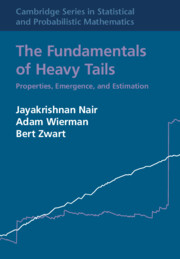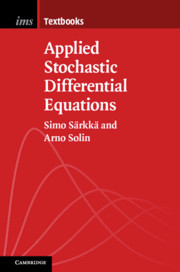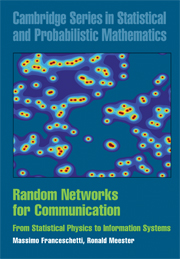The Fundamentals of Heavy Tails
Heavy tails –�extreme events or values more common than expected –�emerge everywhere: the economy, natural events, and social and information networks are just a few examples. Yet after decades of progress, they are still treated as mysterious, surprising, and even controversial, primarily because the necessary mathematical models and statistical methods are not widely known. This book, for the first time, provides a rigorous introduction to heavy-tailed distributions accessible to anyone who knows elementary probability. It tackles and tames the zoo of terminology for models and properties, demystifying topics such as the generalized central limit theorem and regular variation. It tracks the natural emergence of heavy-tailed distributions from a wide variety of general processes, building intuition. And it reveals the controversy surrounding heavy tails to be the result of flawed statistics, then equips readers to identify and estimate with confidence. Over 100 exercises complete this engaging package.
- Generously illustrated with visual comparisons of different heavy-tailed distributions
- Carefully balanced to present deep mathematical concepts without heavy technical machinery
- Enables instructors to augment their curriculum with this crucially important body of knowledge
Reviews & endorsements
‘Heavy tailed distributions are ubiquitous in many disciplines which use probabilistic models. The book by Nair, Wierman and Zwart is a superb introduction to the topic and presents fundamental principles in a rigorous yet accessible manner. It is a must-read for researchers interested in understanding heavy tails.’ R. Srikant, University of Illinois at Urbana-Champaign
‘As one of the people who keeps discovering heavy tails in computer systems, I'm thrilled to see a book that delves into the deeper foundations behind these ubiquitous distributions. This beautifully written book is both mathematically precise and also full of intuitions and examples which make it accessible to newcomers in the field.’ Mor Harchol-Balter, Carnegie Mellon University
‘The book provides a fresh look at heavy-tailed probability distributions on the real line and their role in applied probability. The authors show that these distributions appear via natural algebraic operations. Their approach, towards understanding properties of these distributions, combines the key mathematical ideas alongside with informal explanations. Physical intuition is also provided, for example, the ‘catastrophe/big jump principle’ for heavy-tailed distributions versus the ‘conspiracy principle’ for light-tailed ones. The book is designed to help the practitioner and includes many interesting examples and exercises that may help to the reader to adjust and enjoy its content.’ Sergey Foss, Heriot-Watt University
Product details
May 2022Adobe eBook Reader
9781009062961
0 pages
This ISBN is for an eBook version which is distributed on our behalf by a third party.
Table of Contents
- Commonly used notation
- 1. Introduction
- Part I. Properties:
- 2. Scale invariance, power laws, and regular variation
- 3. Catastrophes, conspiracies, and subexponential distributions
- 4. Residual lives, hazard rates, and long tails
- Part II. Emergence:
- 5. Additive processes
- 6. Multiplicative processes
- 7. Extremal processes
- Part III. Estimation:
- 8. Estimating power-law distributions: Listen to the body
- 9. Estimating power-law tails: Let the tail do the talking
- References
- Index.






